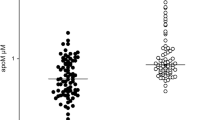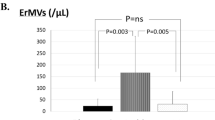Abstract
Behçet’s disease is a systemic vasculitis of unknown aetiology. Endothelial cell injury plays an important role in the pathogenesis and immunopathology of Behçet’s disease. E-selectin is expressed by activated endothelial cells. Because the selectin adhesion molecules are shed from activated cells, soluble forms of these proteins can be used as activation markers of endothelium (E-selectin). The pathogenesis of Behçet’s disease (BD) is closely related to endothelial cells, leucocyte functions and immunity. The aim of this study was to investigate circulating E-selectin adhesion molecules, which are known to play a significant part in the immune response especially by regulating interaction of the leucocytes with endothelium in BD. Plasma E-selectin concentrations were evaluated in 23 patients with BD and 20 healthy control subjects. The disease activity was evaluated by clinical manifestations (oral aphthous ulcer, genital ulceration, positive pathergy test, skin lesions, eye involvement, thrombophlebitis and arthritis) and by laboratory investigations [erythrocyte sedimentation rate (ESR) and C-reactive protein (CRP)]. The patients were newly or previously diagnosed cases not taking any drug for BD. Levels of E-selectin were measured with commercially available sandwich enzyme- linked immunosorbent assay (ELISA) kits using human sE-selectin (cat. no: BMS 205). Plasma E-selectin concentrations of patients and controls were compared with the Mann-Whitney U test. Statistical significance was assigned to p values lower than 0.05. Serum levels (mean±SD) of soluble E-selectin (sE-selectin) were significantly higher in 23 patients with BD than in 20 healthy controls (53.2 ± 18.2 ng/ml vs 33.8 ± 7.5 ng/ml, p < 0.0001). A statistically significant positive correlation was observed between sE-selectin levels and CRP and ESR in patients with BD (r = 0. 78, p < 0.001 and r = 0.56, p < 0.01, respectively). Increases in the E-selectin in BD may be a direct consequence of the leucocyte and endothelium activations observed during the disease process. The noninvasive investigations can be used as biochemical markers for inflammation. This may provide additional information regarding disease activity along with the traditional indices such as ESR and CRP.
Similar content being viewed by others
References
Triolo G, Accardo-Palumbo A, Triolo G et al (1999) Enhancement of endothelial cell E-selectin expression by sera from patients with active Behçet’s disease: moderate correlation with antiendothelial cell antibodies and serum myeloperoxidase levels. Clin Immunol 91:330–337
Jorizzo JL, Salomon A, Zanelli M (1988) Neutrophilic vascular reactions. J Am Acad Dermatol 19:983–1006
Sakane T (1989) Significance of immune abnormalities in the pathoetiology of Behçet’s disease. In: Behçet’s disease. Fifth International Conference, Rochester, MN, 14–15 September 1989
Pall AA, Savage COS (1995) The role of endothelium in systemic vasculitis. In: Savage COS, Pearson JED (eds) Immunological aspect of the vascular endothelium. Cambridge University Press, Cambridge, UK, pp 173–199
Mojcik CF, Shevach EM (1997) Adhesion molecules; a rheumatologic perspective. Arthritis Rheum 40:991–1004
Springer TA (1994) Traffic signals for lymphocyte recirculation and leucocyte emigration: the multistep paradigm. Cell 76:301–314
Spronk PE, Bootsma H, Huitema PC et al (1994) Levels of soluble VCAM-1, soluble ICAM-1 and soluble E-selectin during disease exacerbations in patients with systemic lupus erythematosus, a long prospective study. Clin Exp Immunol 97:439–444
Springer TA (1990) Adhesion receptors of the immune system. Nature 364:425–434
Cronstein BN, Weismann G (1993) The adhesion molecules of inflammation. Arthritis Rheum 36:147–157
Koşar A, Haznedaroğlu S, Karaaslan Y et al (1999) Effects of interferon-α2a treatment on serum levels of tumor necrosis factor-α, tumor necrosis factor-α2 receptor, interleukin-2, interleukin-2 receptor, and E-selectin in Behçet’s disease. Rheumatol Int 19:11–14
Dündar S (1988) Vena cava obstruction in Behçet’s disease. J R Soc Med 81:185–186
Lehner T, Batchelor JR, Challacombe SJ et al (1979) An immunogenetic basis for tissue involvement in Behçet’s syndrome. Immunology 37:895–900
Berg M, James SP (1990) Human neutrophils release the Leu-8 lymph node homing receptor during cell activation. Blood 76:2381–2388
Janssen RA, Luqmani RA, Gordon C et al (1994) Correlation of blood levels of soluble vascular cell adhesion molecule-1 with disease activity in systemic lupus erythematosus and vasculitis. Br J Rheumatol 33:1112–1116
Stegeman CA, Tervaert JWC, Huitema MG et al (1994) Serum levels of soluble adhesion molecules intercellular adhesion molecule 1, vascular cell adhesion molecule 1, and E-selectin in patients with Wegener’s granulomatosis. Relationship to disease actlVlty and relevance during followup. Arthritis Rheum 37:1228–1235
Pall AA, Adu D, Drayson M et al (1994) Circulating soluble adhesion molecules in systemic vasculitis. Nephrol Dial Transplant 9:770–774
Collvinent B, Vilardell C, Font C et al (1999) Circulating soluble adhesion molecules in patients with giant cell arteritis. Correlation between siCAM-1 concentrations and disease activity. Ann Rheum Dis 58:189–192
Wellicome SM, Kapahi P, Mason JC et al (1993) Detection of a circulating form of vascular cell adhesion molecule-I: raised levels in rheumatoid arthritis and systemic lupus erythematosus. Clin Exp Immunol 92:412–418
Mackhold KP, Kiener HP, Graninger W et al (1993) Soluble intercellular adhesion molecule-1 in patients with rheumatoid arthritis and systemic lupus erythematosus. Clin Immunol Immunopathol 68:74–78
Cush JJ, Rothlein R, Lindsley HB et al (1993) Increased levels of ICAM-1 in the sera of patients with rheumatoid arthritis. Arthritis Rheum 36:1098–1102
Sari RA, Taysi S, Erdem F et al (2002) Correlation of serum levels of soluble intercellular adhesion molecule-1 with disease activity in systemic lupus erythematosus. Rheumatol Int 21:149–152
International Study Group for Behçet’s Disease (1990) Criteria for diagnosis of Behçet’s disease. Lancet 335:1078–1080
Haznedaroglu IC, Özcebe O, Özdemir O et al (1996) Impaired haemostatic kinetics and endothelial function in Behçet’s disease. J Intern Med 240:181–187
Mege JL, Dilsen N, Sanguedolce V et al (1993) Overproduction of monocyte derived tumor necrosis factor a, interleukin (IL) 6, IL-8 and increased neutrophil superoxide generation in Behçet’s disease. A comparative study with familial Mediterranean fever and healthy subjects. J Rheumatol 20:1544–1549
Zimmermann GA, Prescott SM, Mc Intyre TM (1992) Endothelial interactions with granulocytes: tethering and signaling molecules. Immunol Today 13:93–99
Cid MC, Cebrian M, Font C et al (2000) Cell adhesion molecules in the development of inflammatory infiltrates in giant cell arteritis; inflammation-induced angiogenesis as the preferential site of leukocyte-endothelial cell interactions. Arthritis Rheum 43:184–194
Newman W, Beall LD, Carson CW et al (1993) Soluble E-selectin is found in supernatants of activated endothelial cells and is elevated in the serum of patients with septic shock. J Immunol 150:644–654
Gruschwitz MS, Hornstein OP, Driesch P (1995) Correlation of soluble adhesion molecules in the peripheral blood of scleroderma patients with their in situ expression and white disease activity. Arthritis Rheum 38:184–189
Boehme MW, Schmitt WH, Youinou P et al (1996) Clinical relevance of elevated serum thrombomodulin and soluble E-selectin in patients with Wegener’s granulomatosis and other systemic vasculitides. Am J Med 101:387–394
Koşar A, Haznedaroğlu S, Büyükkaşık Y et al (2000) Selectins in Behçet’s disease. Ann Rheum Dis 59:61–63
Pigott R, Needham LA, Edwards RM et al (1991) Structural and functional studies of the activation antigen ELAM -1 using a panel of monoclonal antibodies. J Immunol 147:130–135
Norris P, Poston RN, Thomas DS et al (1991) The expression of ELAM-1, ICAM-1 and VCAM-1 in experimental cutaneous inflammation: a comparison of Uvb erythema and delayed hypersensitivity. J Invest Dermatol 96:763–770
Karakuzu A, Kataş A, Akçay F (2002) Serum E-selectin and β2-microglobulin levels in Behçet’s disease. J Int Med Res 30:85–88
Haznedaroğlu S, Karaaslan Y, Büyükaşık Y et al (2000) Selectin adhesion molecules in Behçet’s disease. Ann Rheum Dis 59:61–63
Carson CW, Beall LD, Hunder GG et al (1993) Serum ELAM-1 is increased in vasculitis, scleroderma, and systemic lupus erythematosus. J Rheumatol 20:809–814
Collvinent B, Grau JM, L’opez-Soto A et al (1997) Circulating soluble adhesion molecules in patients with classical polyarteritis nodosa. Br J Rheumatol 36:1178–1183
Furukawa S, Imai K, Matsubara T et al (1993) Increased levels of ICAM-1 in Kawasaki disease. Arthritis Rheum 35:672–677
Ara J, Mirapeix E, Arrizabalaga P et al (2001) Circulating soluble adhesion molecules in ANCA-associated vasculitis. Nephrol Dial Transplant 16:276–285
Author information
Authors and Affiliations
Corresponding author
Additional information
An erratum to this article is available at http://dx.doi.org/10.1007/s10067-006-0518-5.
Rights and permissions
About this article
Cite this article
Sari, R.A., Kiziltunç, A., Tays’y, S. et al. Levels of soluble E-selectin in patients with active Behçet’s disease. Clin Rheumatol 24, 55–59 (2005). https://doi.org/10.1007/s10067-004-0982-8
Received:
Accepted:
Published:
Issue Date:
DOI: https://doi.org/10.1007/s10067-004-0982-8




